Clinical Leadership & Governance: Improving Patient Care Quality
VerifiedAdded on 2023/06/15
|8
|2628
|165
Report
AI Summary
This report reflects on the Swiss Cheese Model of Accident Causation to identify processes compromising patient health, explores the interrelationship of clinical leadership and governance in ensuring safe, quality patient care, and considers recommendations for change. The case of Harold Edward, whose death revealed compromised patient safety, is analyzed against EQUIP 6 clinical standards, highlighting failures in clinical handover, coordinated care, and risk management. The report emphasizes the need for robust clinical leadership within clinical governance to improve patient care and safety, suggesting practical changes such as direct patient observation, minimizing patient access to potentially harmful personal items, and enhanced monitoring systems. It concludes that integrating clinical leadership into national quality strategies is crucial for successful implementation of clinical governance and improved patient outcomes.
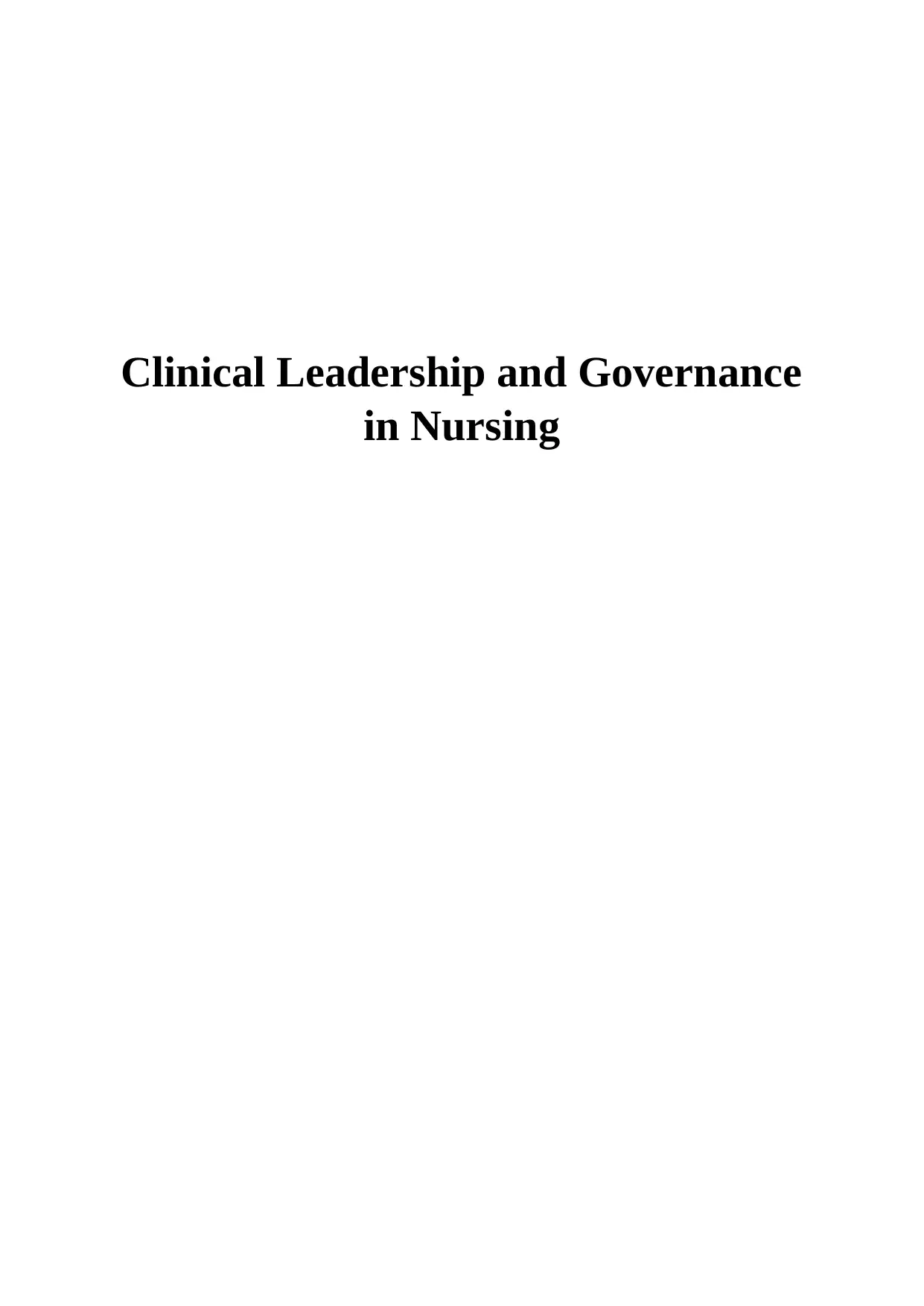
Clinical Leadership and Governance
in Nursing
in Nursing
Paraphrase This Document
Need a fresh take? Get an instant paraphrase of this document with our AI Paraphraser
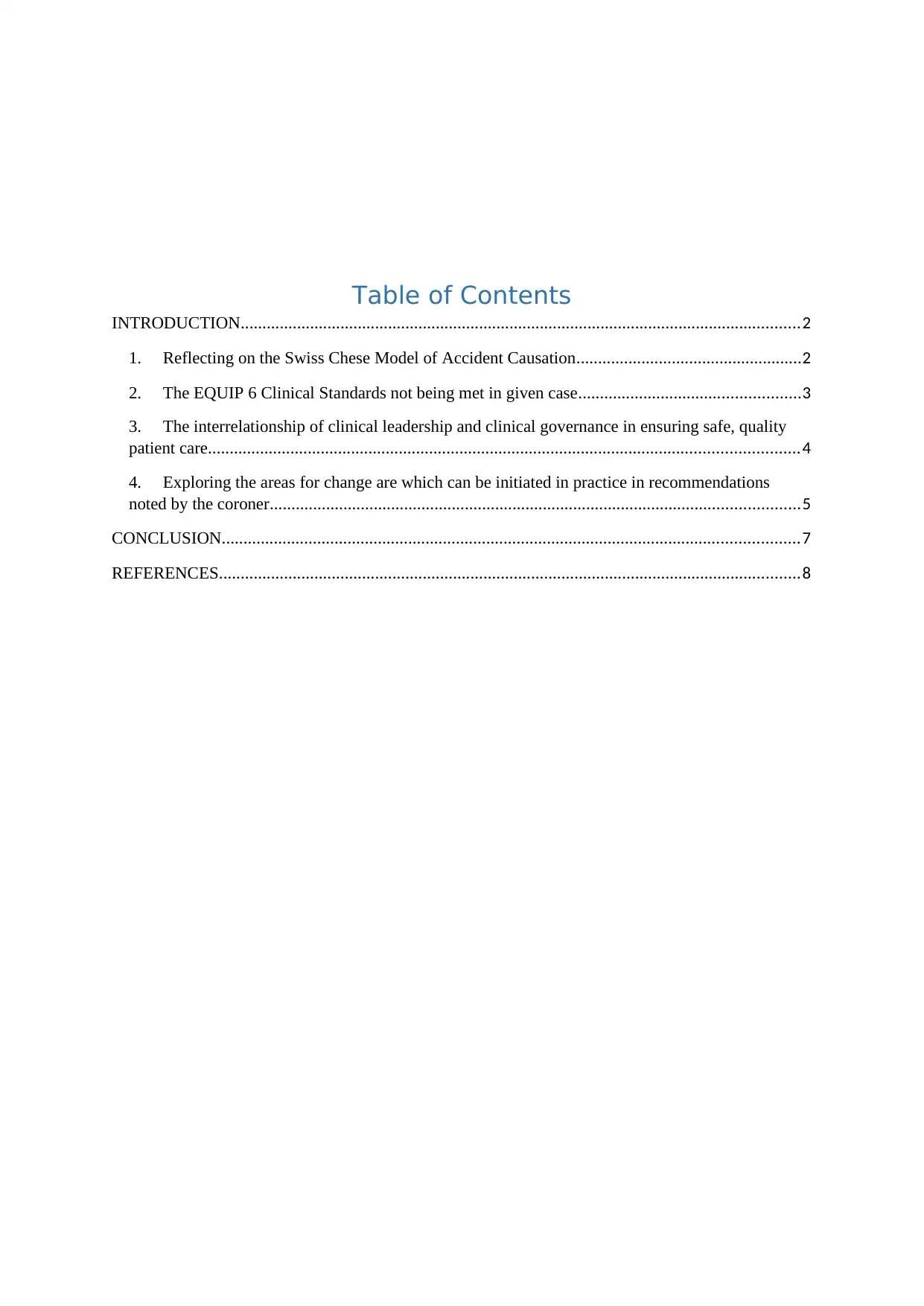
Table of Contents
INTRODUCTION.................................................................................................................................2
1. Reflecting on the Swiss Chese Model of Accident Causation....................................................2
2. The EQUIP 6 Clinical Standards not being met in given case...................................................3
3. The interrelationship of clinical leadership and clinical governance in ensuring safe, quality
patient care........................................................................................................................................4
4. Exploring the areas for change are which can be initiated in practice in recommendations
noted by the coroner..........................................................................................................................5
CONCLUSION.....................................................................................................................................7
REFERENCES......................................................................................................................................8
INTRODUCTION.................................................................................................................................2
1. Reflecting on the Swiss Chese Model of Accident Causation....................................................2
2. The EQUIP 6 Clinical Standards not being met in given case...................................................3
3. The interrelationship of clinical leadership and clinical governance in ensuring safe, quality
patient care........................................................................................................................................4
4. Exploring the areas for change are which can be initiated in practice in recommendations
noted by the coroner..........................................................................................................................5
CONCLUSION.....................................................................................................................................7
REFERENCES......................................................................................................................................8
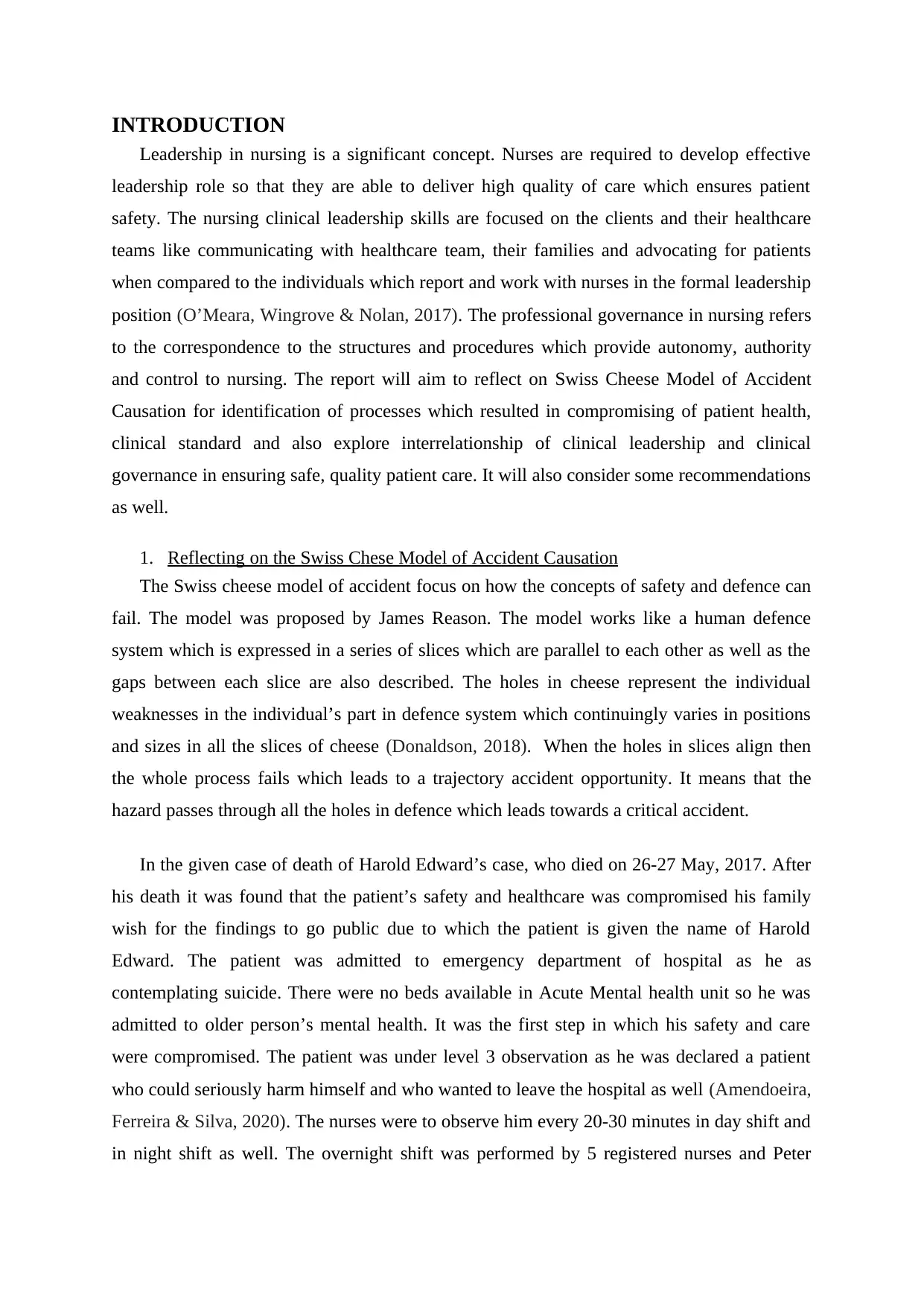
INTRODUCTION
Leadership in nursing is a significant concept. Nurses are required to develop effective
leadership role so that they are able to deliver high quality of care which ensures patient
safety. The nursing clinical leadership skills are focused on the clients and their healthcare
teams like communicating with healthcare team, their families and advocating for patients
when compared to the individuals which report and work with nurses in the formal leadership
position (O’Meara, Wingrove & Nolan, 2017). The professional governance in nursing refers
to the correspondence to the structures and procedures which provide autonomy, authority
and control to nursing. The report will aim to reflect on Swiss Cheese Model of Accident
Causation for identification of processes which resulted in compromising of patient health,
clinical standard and also explore interrelationship of clinical leadership and clinical
governance in ensuring safe, quality patient care. It will also consider some recommendations
as well.
1. Reflecting on the Swiss Chese Model of Accident Causation
The Swiss cheese model of accident focus on how the concepts of safety and defence can
fail. The model was proposed by James Reason. The model works like a human defence
system which is expressed in a series of slices which are parallel to each other as well as the
gaps between each slice are also described. The holes in cheese represent the individual
weaknesses in the individual’s part in defence system which continuingly varies in positions
and sizes in all the slices of cheese (Donaldson, 2018). When the holes in slices align then
the whole process fails which leads to a trajectory accident opportunity. It means that the
hazard passes through all the holes in defence which leads towards a critical accident.
In the given case of death of Harold Edward’s case, who died on 26-27 May, 2017. After
his death it was found that the patient’s safety and healthcare was compromised his family
wish for the findings to go public due to which the patient is given the name of Harold
Edward. The patient was admitted to emergency department of hospital as he as
contemplating suicide. There were no beds available in Acute Mental health unit so he was
admitted to older person’s mental health. It was the first step in which his safety and care
were compromised. The patient was under level 3 observation as he was declared a patient
who could seriously harm himself and who wanted to leave the hospital as well (Amendoeira,
Ferreira & Silva, 2020). The nurses were to observe him every 20-30 minutes in day shift and
in night shift as well. The overnight shift was performed by 5 registered nurses and Peter
Leadership in nursing is a significant concept. Nurses are required to develop effective
leadership role so that they are able to deliver high quality of care which ensures patient
safety. The nursing clinical leadership skills are focused on the clients and their healthcare
teams like communicating with healthcare team, their families and advocating for patients
when compared to the individuals which report and work with nurses in the formal leadership
position (O’Meara, Wingrove & Nolan, 2017). The professional governance in nursing refers
to the correspondence to the structures and procedures which provide autonomy, authority
and control to nursing. The report will aim to reflect on Swiss Cheese Model of Accident
Causation for identification of processes which resulted in compromising of patient health,
clinical standard and also explore interrelationship of clinical leadership and clinical
governance in ensuring safe, quality patient care. It will also consider some recommendations
as well.
1. Reflecting on the Swiss Chese Model of Accident Causation
The Swiss cheese model of accident focus on how the concepts of safety and defence can
fail. The model was proposed by James Reason. The model works like a human defence
system which is expressed in a series of slices which are parallel to each other as well as the
gaps between each slice are also described. The holes in cheese represent the individual
weaknesses in the individual’s part in defence system which continuingly varies in positions
and sizes in all the slices of cheese (Donaldson, 2018). When the holes in slices align then
the whole process fails which leads to a trajectory accident opportunity. It means that the
hazard passes through all the holes in defence which leads towards a critical accident.
In the given case of death of Harold Edward’s case, who died on 26-27 May, 2017. After
his death it was found that the patient’s safety and healthcare was compromised his family
wish for the findings to go public due to which the patient is given the name of Harold
Edward. The patient was admitted to emergency department of hospital as he as
contemplating suicide. There were no beds available in Acute Mental health unit so he was
admitted to older person’s mental health. It was the first step in which his safety and care
were compromised. The patient was under level 3 observation as he was declared a patient
who could seriously harm himself and who wanted to leave the hospital as well (Amendoeira,
Ferreira & Silva, 2020). The nurses were to observe him every 20-30 minutes in day shift and
in night shift as well. The overnight shift was performed by 5 registered nurses and Peter
You're viewing a preview
Unlock full access by subscribing today!
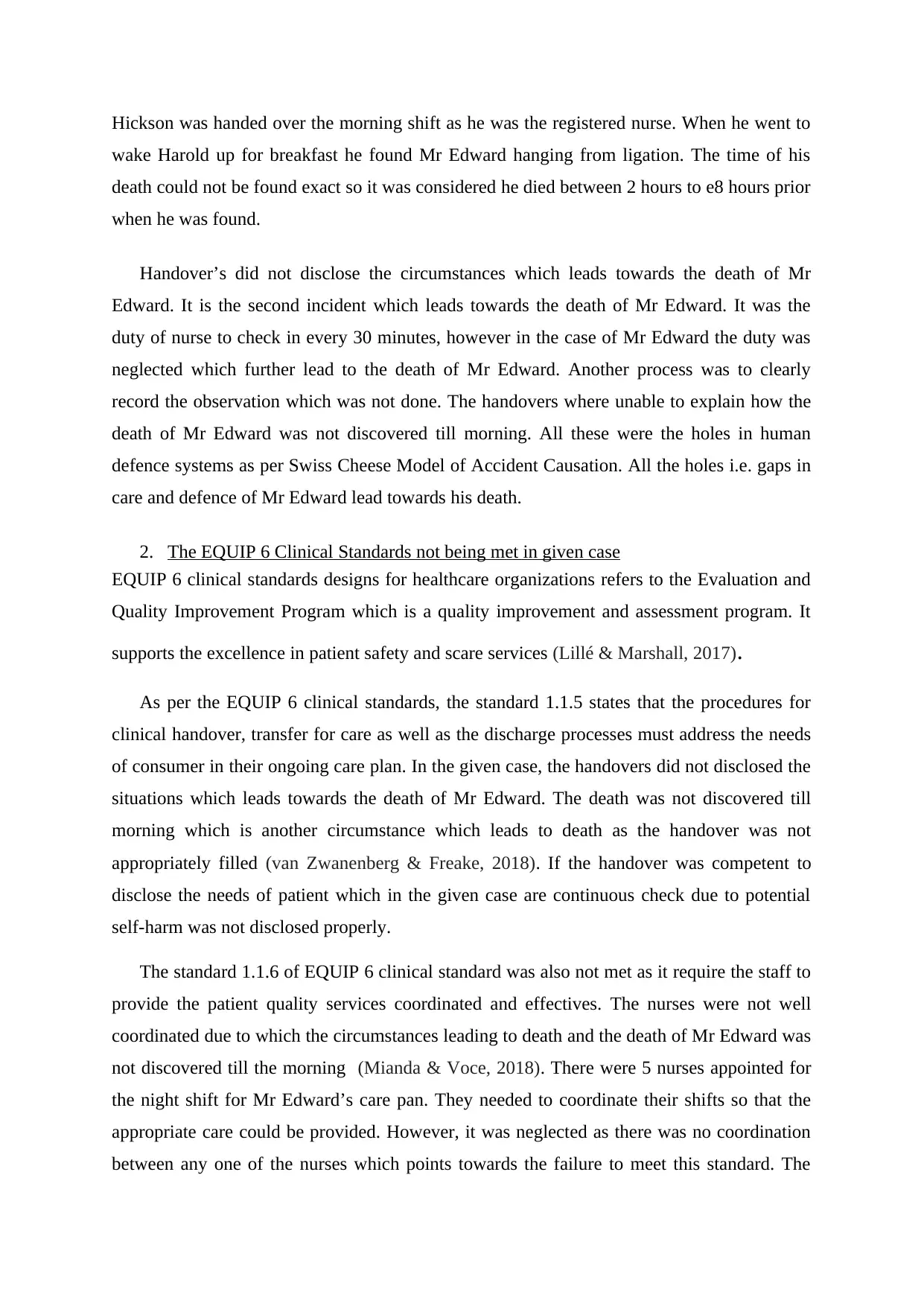
Hickson was handed over the morning shift as he was the registered nurse. When he went to
wake Harold up for breakfast he found Mr Edward hanging from ligation. The time of his
death could not be found exact so it was considered he died between 2 hours to e8 hours prior
when he was found.
Handover’s did not disclose the circumstances which leads towards the death of Mr
Edward. It is the second incident which leads towards the death of Mr Edward. It was the
duty of nurse to check in every 30 minutes, however in the case of Mr Edward the duty was
neglected which further lead to the death of Mr Edward. Another process was to clearly
record the observation which was not done. The handovers where unable to explain how the
death of Mr Edward was not discovered till morning. All these were the holes in human
defence systems as per Swiss Cheese Model of Accident Causation. All the holes i.e. gaps in
care and defence of Mr Edward lead towards his death.
2. The EQUIP 6 Clinical Standards not being met in given case
EQUIP 6 clinical standards designs for healthcare organizations refers to the Evaluation and
Quality Improvement Program which is a quality improvement and assessment program. It
supports the excellence in patient safety and scare services (Lillé & Marshall, 2017).
As per the EQUIP 6 clinical standards, the standard 1.1.5 states that the procedures for
clinical handover, transfer for care as well as the discharge processes must address the needs
of consumer in their ongoing care plan. In the given case, the handovers did not disclosed the
situations which leads towards the death of Mr Edward. The death was not discovered till
morning which is another circumstance which leads to death as the handover was not
appropriately filled (van Zwanenberg & Freake, 2018). If the handover was competent to
disclose the needs of patient which in the given case are continuous check due to potential
self-harm was not disclosed properly.
The standard 1.1.6 of EQUIP 6 clinical standard was also not met as it require the staff to
provide the patient quality services coordinated and effectives. The nurses were not well
coordinated due to which the circumstances leading to death and the death of Mr Edward was
not discovered till the morning (Mianda & Voce, 2018). There were 5 nurses appointed for
the night shift for Mr Edward’s care pan. They needed to coordinate their shifts so that the
appropriate care could be provided. However, it was neglected as there was no coordination
between any one of the nurses which points towards the failure to meet this standard. The
wake Harold up for breakfast he found Mr Edward hanging from ligation. The time of his
death could not be found exact so it was considered he died between 2 hours to e8 hours prior
when he was found.
Handover’s did not disclose the circumstances which leads towards the death of Mr
Edward. It is the second incident which leads towards the death of Mr Edward. It was the
duty of nurse to check in every 30 minutes, however in the case of Mr Edward the duty was
neglected which further lead to the death of Mr Edward. Another process was to clearly
record the observation which was not done. The handovers where unable to explain how the
death of Mr Edward was not discovered till morning. All these were the holes in human
defence systems as per Swiss Cheese Model of Accident Causation. All the holes i.e. gaps in
care and defence of Mr Edward lead towards his death.
2. The EQUIP 6 Clinical Standards not being met in given case
EQUIP 6 clinical standards designs for healthcare organizations refers to the Evaluation and
Quality Improvement Program which is a quality improvement and assessment program. It
supports the excellence in patient safety and scare services (Lillé & Marshall, 2017).
As per the EQUIP 6 clinical standards, the standard 1.1.5 states that the procedures for
clinical handover, transfer for care as well as the discharge processes must address the needs
of consumer in their ongoing care plan. In the given case, the handovers did not disclosed the
situations which leads towards the death of Mr Edward. The death was not discovered till
morning which is another circumstance which leads to death as the handover was not
appropriately filled (van Zwanenberg & Freake, 2018). If the handover was competent to
disclose the needs of patient which in the given case are continuous check due to potential
self-harm was not disclosed properly.
The standard 1.1.6 of EQUIP 6 clinical standard was also not met as it require the staff to
provide the patient quality services coordinated and effectives. The nurses were not well
coordinated due to which the circumstances leading to death and the death of Mr Edward was
not discovered till the morning (Mianda & Voce, 2018). There were 5 nurses appointed for
the night shift for Mr Edward’s care pan. They needed to coordinate their shifts so that the
appropriate care could be provided. However, it was neglected as there was no coordination
between any one of the nurses which points towards the failure to meet this standard. The
Paraphrase This Document
Need a fresh take? Get an instant paraphrase of this document with our AI Paraphraser
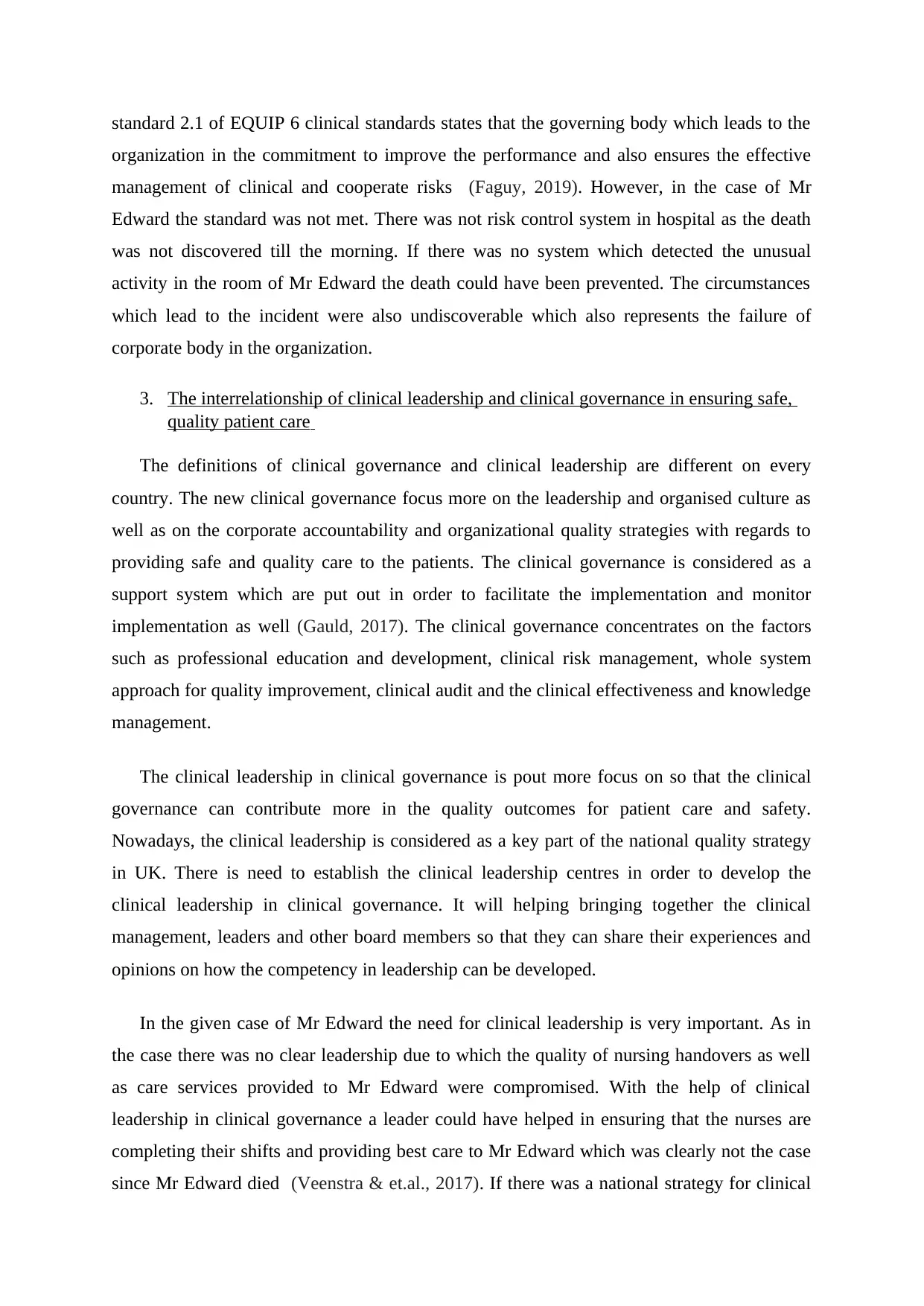
standard 2.1 of EQUIP 6 clinical standards states that the governing body which leads to the
organization in the commitment to improve the performance and also ensures the effective
management of clinical and cooperate risks (Faguy, 2019). However, in the case of Mr
Edward the standard was not met. There was not risk control system in hospital as the death
was not discovered till the morning. If there was no system which detected the unusual
activity in the room of Mr Edward the death could have been prevented. The circumstances
which lead to the incident were also undiscoverable which also represents the failure of
corporate body in the organization.
3. The interrelationship of clinical leadership and clinical governance in ensuring safe,
quality patient care
The definitions of clinical governance and clinical leadership are different on every
country. The new clinical governance focus more on the leadership and organised culture as
well as on the corporate accountability and organizational quality strategies with regards to
providing safe and quality care to the patients. The clinical governance is considered as a
support system which are put out in order to facilitate the implementation and monitor
implementation as well (Gauld, 2017). The clinical governance concentrates on the factors
such as professional education and development, clinical risk management, whole system
approach for quality improvement, clinical audit and the clinical effectiveness and knowledge
management.
The clinical leadership in clinical governance is pout more focus on so that the clinical
governance can contribute more in the quality outcomes for patient care and safety.
Nowadays, the clinical leadership is considered as a key part of the national quality strategy
in UK. There is need to establish the clinical leadership centres in order to develop the
clinical leadership in clinical governance. It will helping bringing together the clinical
management, leaders and other board members so that they can share their experiences and
opinions on how the competency in leadership can be developed.
In the given case of Mr Edward the need for clinical leadership is very important. As in
the case there was no clear leadership due to which the quality of nursing handovers as well
as care services provided to Mr Edward were compromised. With the help of clinical
leadership in clinical governance a leader could have helped in ensuring that the nurses are
completing their shifts and providing best care to Mr Edward which was clearly not the case
since Mr Edward died (Veenstra & et.al., 2017). If there was a national strategy for clinical
organization in the commitment to improve the performance and also ensures the effective
management of clinical and cooperate risks (Faguy, 2019). However, in the case of Mr
Edward the standard was not met. There was not risk control system in hospital as the death
was not discovered till the morning. If there was no system which detected the unusual
activity in the room of Mr Edward the death could have been prevented. The circumstances
which lead to the incident were also undiscoverable which also represents the failure of
corporate body in the organization.
3. The interrelationship of clinical leadership and clinical governance in ensuring safe,
quality patient care
The definitions of clinical governance and clinical leadership are different on every
country. The new clinical governance focus more on the leadership and organised culture as
well as on the corporate accountability and organizational quality strategies with regards to
providing safe and quality care to the patients. The clinical governance is considered as a
support system which are put out in order to facilitate the implementation and monitor
implementation as well (Gauld, 2017). The clinical governance concentrates on the factors
such as professional education and development, clinical risk management, whole system
approach for quality improvement, clinical audit and the clinical effectiveness and knowledge
management.
The clinical leadership in clinical governance is pout more focus on so that the clinical
governance can contribute more in the quality outcomes for patient care and safety.
Nowadays, the clinical leadership is considered as a key part of the national quality strategy
in UK. There is need to establish the clinical leadership centres in order to develop the
clinical leadership in clinical governance. It will helping bringing together the clinical
management, leaders and other board members so that they can share their experiences and
opinions on how the competency in leadership can be developed.
In the given case of Mr Edward the need for clinical leadership is very important. As in
the case there was no clear leadership due to which the quality of nursing handovers as well
as care services provided to Mr Edward were compromised. With the help of clinical
leadership in clinical governance a leader could have helped in ensuring that the nurses are
completing their shifts and providing best care to Mr Edward which was clearly not the case
since Mr Edward died (Veenstra & et.al., 2017). If there was a national strategy for clinical
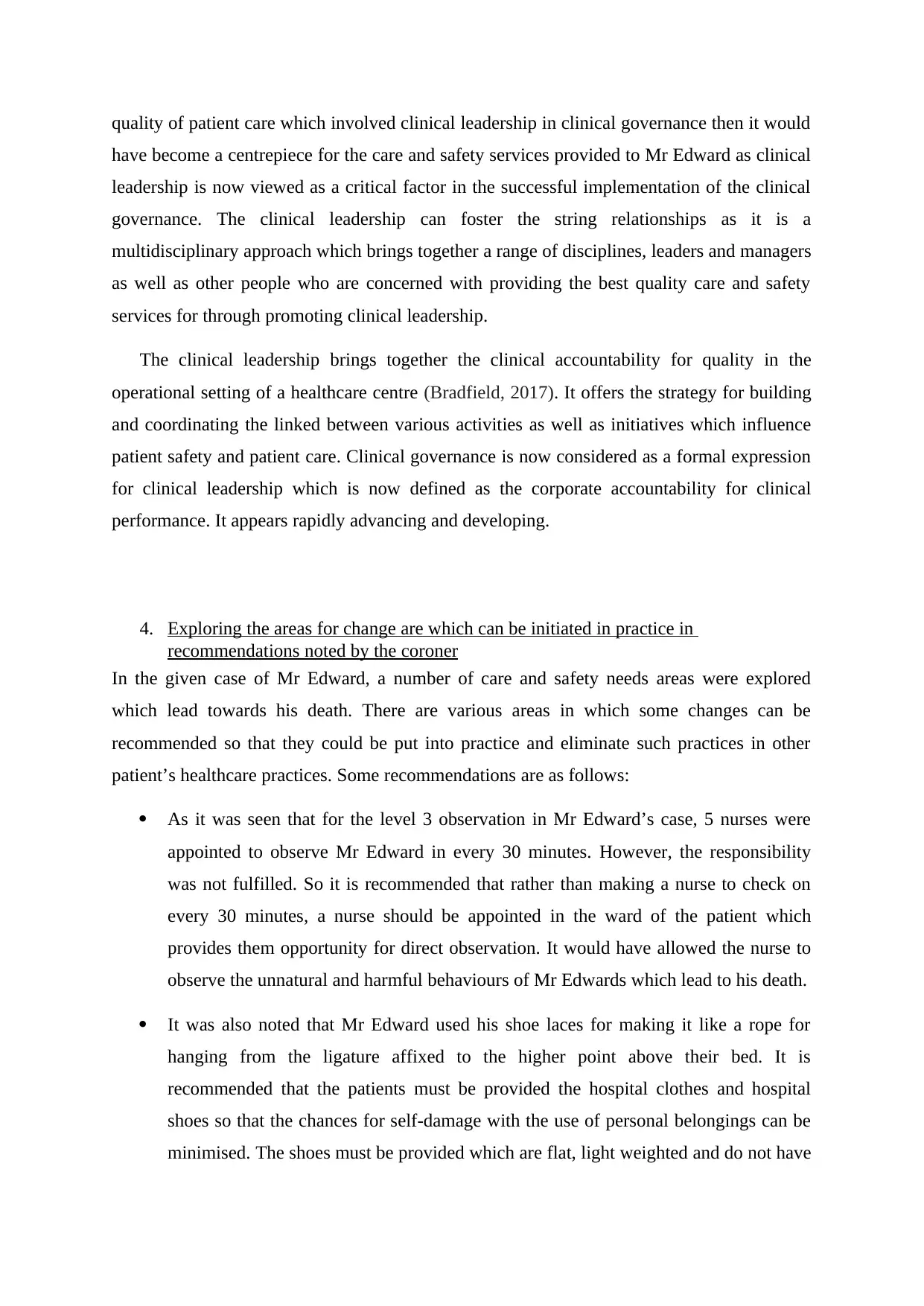
quality of patient care which involved clinical leadership in clinical governance then it would
have become a centrepiece for the care and safety services provided to Mr Edward as clinical
leadership is now viewed as a critical factor in the successful implementation of the clinical
governance. The clinical leadership can foster the string relationships as it is a
multidisciplinary approach which brings together a range of disciplines, leaders and managers
as well as other people who are concerned with providing the best quality care and safety
services for through promoting clinical leadership.
The clinical leadership brings together the clinical accountability for quality in the
operational setting of a healthcare centre (Bradfield, 2017). It offers the strategy for building
and coordinating the linked between various activities as well as initiatives which influence
patient safety and patient care. Clinical governance is now considered as a formal expression
for clinical leadership which is now defined as the corporate accountability for clinical
performance. It appears rapidly advancing and developing.
4. Exploring the areas for change are which can be initiated in practice in
recommendations noted by the coroner
In the given case of Mr Edward, a number of care and safety needs areas were explored
which lead towards his death. There are various areas in which some changes can be
recommended so that they could be put into practice and eliminate such practices in other
patient’s healthcare practices. Some recommendations are as follows:
As it was seen that for the level 3 observation in Mr Edward’s case, 5 nurses were
appointed to observe Mr Edward in every 30 minutes. However, the responsibility
was not fulfilled. So it is recommended that rather than making a nurse to check on
every 30 minutes, a nurse should be appointed in the ward of the patient which
provides them opportunity for direct observation. It would have allowed the nurse to
observe the unnatural and harmful behaviours of Mr Edwards which lead to his death.
It was also noted that Mr Edward used his shoe laces for making it like a rope for
hanging from the ligature affixed to the higher point above their bed. It is
recommended that the patients must be provided the hospital clothes and hospital
shoes so that the chances for self-damage with the use of personal belongings can be
minimised. The shoes must be provided which are flat, light weighted and do not have
have become a centrepiece for the care and safety services provided to Mr Edward as clinical
leadership is now viewed as a critical factor in the successful implementation of the clinical
governance. The clinical leadership can foster the string relationships as it is a
multidisciplinary approach which brings together a range of disciplines, leaders and managers
as well as other people who are concerned with providing the best quality care and safety
services for through promoting clinical leadership.
The clinical leadership brings together the clinical accountability for quality in the
operational setting of a healthcare centre (Bradfield, 2017). It offers the strategy for building
and coordinating the linked between various activities as well as initiatives which influence
patient safety and patient care. Clinical governance is now considered as a formal expression
for clinical leadership which is now defined as the corporate accountability for clinical
performance. It appears rapidly advancing and developing.
4. Exploring the areas for change are which can be initiated in practice in
recommendations noted by the coroner
In the given case of Mr Edward, a number of care and safety needs areas were explored
which lead towards his death. There are various areas in which some changes can be
recommended so that they could be put into practice and eliminate such practices in other
patient’s healthcare practices. Some recommendations are as follows:
As it was seen that for the level 3 observation in Mr Edward’s case, 5 nurses were
appointed to observe Mr Edward in every 30 minutes. However, the responsibility
was not fulfilled. So it is recommended that rather than making a nurse to check on
every 30 minutes, a nurse should be appointed in the ward of the patient which
provides them opportunity for direct observation. It would have allowed the nurse to
observe the unnatural and harmful behaviours of Mr Edwards which lead to his death.
It was also noted that Mr Edward used his shoe laces for making it like a rope for
hanging from the ligature affixed to the higher point above their bed. It is
recommended that the patients must be provided the hospital clothes and hospital
shoes so that the chances for self-damage with the use of personal belongings can be
minimised. The shoes must be provided which are flat, light weighted and do not have
You're viewing a preview
Unlock full access by subscribing today!
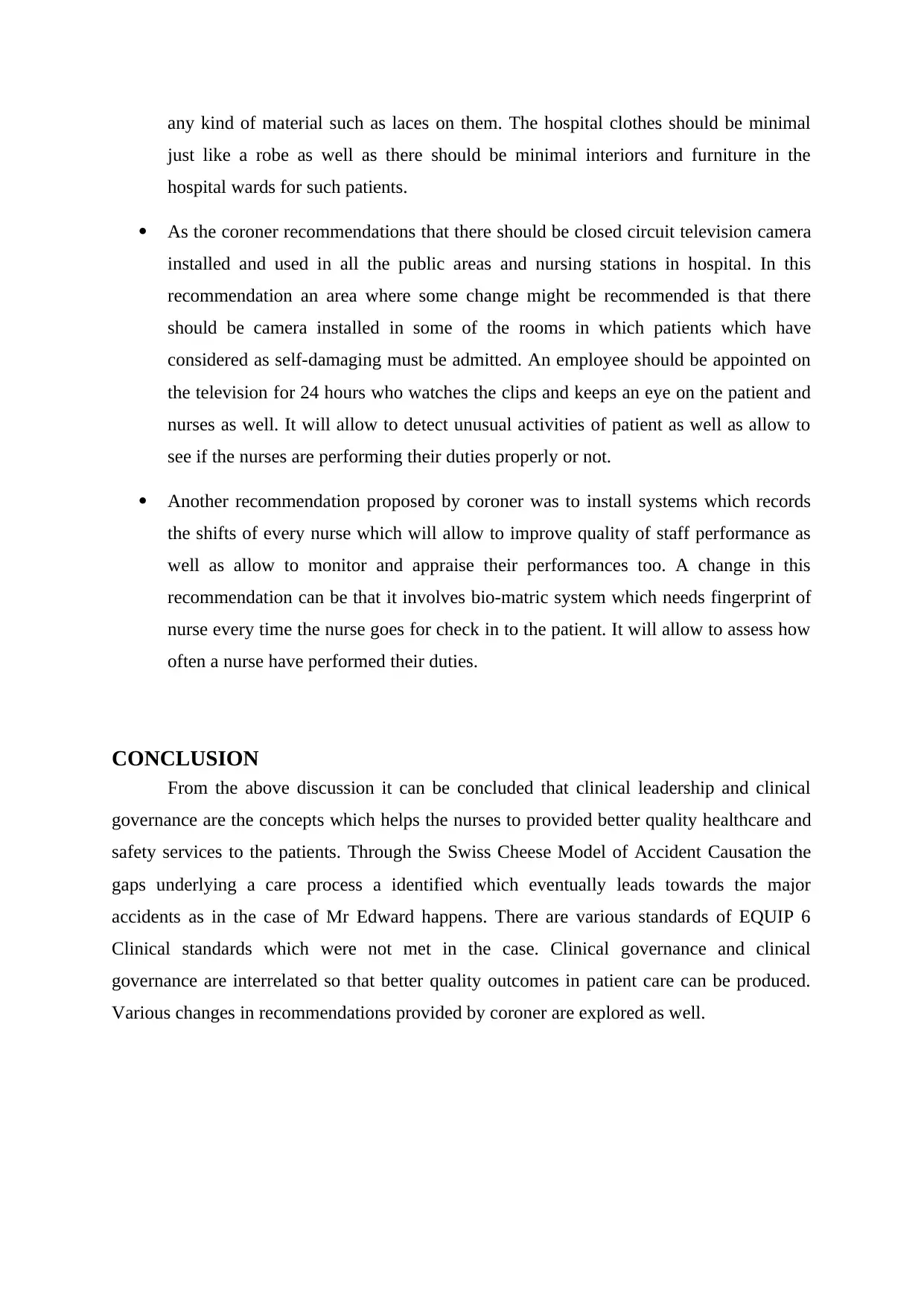
any kind of material such as laces on them. The hospital clothes should be minimal
just like a robe as well as there should be minimal interiors and furniture in the
hospital wards for such patients.
As the coroner recommendations that there should be closed circuit television camera
installed and used in all the public areas and nursing stations in hospital. In this
recommendation an area where some change might be recommended is that there
should be camera installed in some of the rooms in which patients which have
considered as self-damaging must be admitted. An employee should be appointed on
the television for 24 hours who watches the clips and keeps an eye on the patient and
nurses as well. It will allow to detect unusual activities of patient as well as allow to
see if the nurses are performing their duties properly or not.
Another recommendation proposed by coroner was to install systems which records
the shifts of every nurse which will allow to improve quality of staff performance as
well as allow to monitor and appraise their performances too. A change in this
recommendation can be that it involves bio-matric system which needs fingerprint of
nurse every time the nurse goes for check in to the patient. It will allow to assess how
often a nurse have performed their duties.
CONCLUSION
From the above discussion it can be concluded that clinical leadership and clinical
governance are the concepts which helps the nurses to provided better quality healthcare and
safety services to the patients. Through the Swiss Cheese Model of Accident Causation the
gaps underlying a care process a identified which eventually leads towards the major
accidents as in the case of Mr Edward happens. There are various standards of EQUIP 6
Clinical standards which were not met in the case. Clinical governance and clinical
governance are interrelated so that better quality outcomes in patient care can be produced.
Various changes in recommendations provided by coroner are explored as well.
just like a robe as well as there should be minimal interiors and furniture in the
hospital wards for such patients.
As the coroner recommendations that there should be closed circuit television camera
installed and used in all the public areas and nursing stations in hospital. In this
recommendation an area where some change might be recommended is that there
should be camera installed in some of the rooms in which patients which have
considered as self-damaging must be admitted. An employee should be appointed on
the television for 24 hours who watches the clips and keeps an eye on the patient and
nurses as well. It will allow to detect unusual activities of patient as well as allow to
see if the nurses are performing their duties properly or not.
Another recommendation proposed by coroner was to install systems which records
the shifts of every nurse which will allow to improve quality of staff performance as
well as allow to monitor and appraise their performances too. A change in this
recommendation can be that it involves bio-matric system which needs fingerprint of
nurse every time the nurse goes for check in to the patient. It will allow to assess how
often a nurse have performed their duties.
CONCLUSION
From the above discussion it can be concluded that clinical leadership and clinical
governance are the concepts which helps the nurses to provided better quality healthcare and
safety services to the patients. Through the Swiss Cheese Model of Accident Causation the
gaps underlying a care process a identified which eventually leads towards the major
accidents as in the case of Mr Edward happens. There are various standards of EQUIP 6
Clinical standards which were not met in the case. Clinical governance and clinical
governance are interrelated so that better quality outcomes in patient care can be produced.
Various changes in recommendations provided by coroner are explored as well.
Paraphrase This Document
Need a fresh take? Get an instant paraphrase of this document with our AI Paraphraser
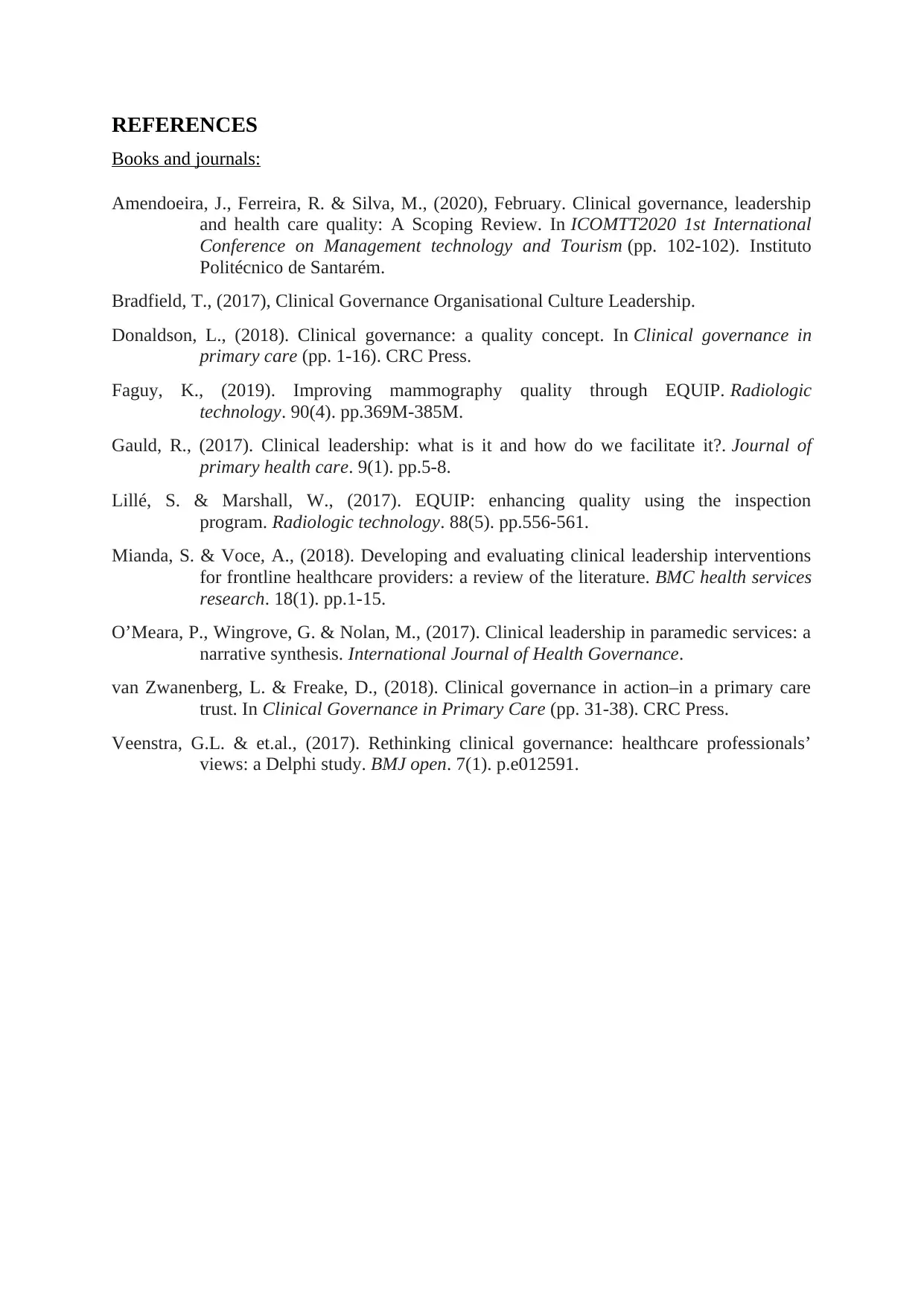
REFERENCES
Books and journals:
Amendoeira, J., Ferreira, R. & Silva, M., (2020), February. Clinical governance, leadership
and health care quality: A Scoping Review. In ICOMTT2020 1st International
Conference on Management technology and Tourism (pp. 102-102). Instituto
Politécnico de Santarém.
Bradfield, T., (2017), Clinical Governance Organisational Culture Leadership.
Donaldson, L., (2018). Clinical governance: a quality concept. In Clinical governance in
primary care (pp. 1-16). CRC Press.
Faguy, K., (2019). Improving mammography quality through EQUIP. Radiologic
technology. 90(4). pp.369M-385M.
Gauld, R., (2017). Clinical leadership: what is it and how do we facilitate it?. Journal of
primary health care. 9(1). pp.5-8.
Lillé, S. & Marshall, W., (2017). EQUIP: enhancing quality using the inspection
program. Radiologic technology. 88(5). pp.556-561.
Mianda, S. & Voce, A., (2018). Developing and evaluating clinical leadership interventions
for frontline healthcare providers: a review of the literature. BMC health services
research. 18(1). pp.1-15.
O’Meara, P., Wingrove, G. & Nolan, M., (2017). Clinical leadership in paramedic services: a
narrative synthesis. International Journal of Health Governance.
van Zwanenberg, L. & Freake, D., (2018). Clinical governance in action–in a primary care
trust. In Clinical Governance in Primary Care (pp. 31-38). CRC Press.
Veenstra, G.L. & et.al., (2017). Rethinking clinical governance: healthcare professionals’
views: a Delphi study. BMJ open. 7(1). p.e012591.
Books and journals:
Amendoeira, J., Ferreira, R. & Silva, M., (2020), February. Clinical governance, leadership
and health care quality: A Scoping Review. In ICOMTT2020 1st International
Conference on Management technology and Tourism (pp. 102-102). Instituto
Politécnico de Santarém.
Bradfield, T., (2017), Clinical Governance Organisational Culture Leadership.
Donaldson, L., (2018). Clinical governance: a quality concept. In Clinical governance in
primary care (pp. 1-16). CRC Press.
Faguy, K., (2019). Improving mammography quality through EQUIP. Radiologic
technology. 90(4). pp.369M-385M.
Gauld, R., (2017). Clinical leadership: what is it and how do we facilitate it?. Journal of
primary health care. 9(1). pp.5-8.
Lillé, S. & Marshall, W., (2017). EQUIP: enhancing quality using the inspection
program. Radiologic technology. 88(5). pp.556-561.
Mianda, S. & Voce, A., (2018). Developing and evaluating clinical leadership interventions
for frontline healthcare providers: a review of the literature. BMC health services
research. 18(1). pp.1-15.
O’Meara, P., Wingrove, G. & Nolan, M., (2017). Clinical leadership in paramedic services: a
narrative synthesis. International Journal of Health Governance.
van Zwanenberg, L. & Freake, D., (2018). Clinical governance in action–in a primary care
trust. In Clinical Governance in Primary Care (pp. 31-38). CRC Press.
Veenstra, G.L. & et.al., (2017). Rethinking clinical governance: healthcare professionals’
views: a Delphi study. BMJ open. 7(1). p.e012591.
1 out of 8
Related Documents
Your All-in-One AI-Powered Toolkit for Academic Success.
+13062052269
info@desklib.com
Available 24*7 on WhatsApp / Email
![[object Object]](/_next/static/media/star-bottom.7253800d.svg)
Unlock your academic potential
© 2024 | Zucol Services PVT LTD | All rights reserved.





